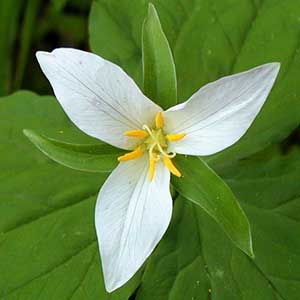Trillium ovatum
Trillium luteum
Pacific trillium, trillium, western trillium, western wake-robin, western white trillium, white or western trillium, white trillium
wax trillium, yellow toadshade, yellow trillium, yellow wakerobin
semierect to horizontal, short, stout, praemorse.
horizontal, brownish, short, thick, praemorse, not brittle.
1–2, round, 2–5 dm, ± slender, glabrous.
1–4, round in cross section, 1.4–4 dm, stout, glabrous.
sessile, subsessile, or short-petiolate;
blade medium green, sometimes blotched and mottled, main veins prominent, ovate-rhombic, 7–12 × 5–20 cm, continuing to expand during anthesis, base rounded, apex acuminate.
held well above ground, sessile;
blade mottled, mottling becoming more obscure as growth matures, shape variable, ovate-elliptic to ± orbicular-acuminate, 6.5–17 × 6.5–9.8 cm, not glossy, apex acuminate to long-acuminate.
erect or nodding, odorless;
sepals spreading to horizontal, green, lanceolate to oblong-lanceolate, 15–50 × 6–20 mm, margins entire, apex acute;
petals erect-ascending, usually wide-spreading from base, exposing entire pistil, white or with pink or blush markings, lacking V-shaped markings, fading to rosy pink, purple, or dark red, veins not deeply engraved, ± linear to widely obovate, 1.5–7 ×1–4 cm, widest at or above middle, thin-textured, margins flat to undulate, apex acuminate;
stamens prominent, slightly recurved-spreading to straight, 10–18 mm;
filaments white, shorter than anthers, slender;
anthers yellow, 4–16 mm, slender, dehiscence latrorse-introrse;
ovary green or white, ovoid, 6-angled, 5–12 mm, attachment ± 3/4 ovary width;
stigmas recurved, barely connate basally, greenish white or white, linear, not lobed adaxially, 6–10 mm, uniformly thin;
pedicel erect to leaning, 2–6 cm.
erect, odor strongly lemony;
sepals displayed above bracts, widely spreading, green, oblong-lanceolate, lanceolate, or oblong-elliptic, 22–47 × 8–9 mm, margins entire, apex distinctly rounded-acute;
petals long-lasting, erect, ± connivent, ± concealing stamens and ovary, greenish yellow to lemon yellow, not spirally twisted, not clawed, elliptic-lanceolate, lanceolate, or oblanceolate, 3.4–6.6 × 1–2.1 cm, thick-textured, widest near base, margins entire, tapering to long-acuminate apex;
stamens erect, 11–18 mm;
filaments greenish white, 1.5–2 mm, basally dilated;
anthers erect, straight, yellow, 9–16 mm, dehiscence introrse (or appearing lateral);
connectives green, straight, broad, extending only slightly (to 0.5 mm) or not at all beyond anther sacs;
ovary pale green, ovoid to globose, 6-angled, 5–8 mm;
stigmas erect, barely spreading, distinct, greenish white, sessile, linear to subulate, 3–4 mm, fleshy.
baccate, green or white, ± odorless, broadly ovoid, obscurely winged, 1.2–2.8 × 0.7–1.9 cm, pulpy-moist.
green to greenish white, occasionally with dark streaks, odor not reported, ovoid, 6-angled, 3.5 × 2 cm, pulpy.
= 10.
= 10.
Trillium ovatum
Trillium luteum
Varieties 2 (2 in the flora).
(Discussion copyrighted by Flora of North America; reprinted with permission.)
Botanists have been confused by Trillium luteum for a long time. Some, such as A. E. Radford et al. (1968), appear to regard it as a form of T. cuneatum, while others confuse it with T. viride, a more western species. Early botanists confused T. luteum with the occasional individual or very local larger population of pallid color forms of other species. Trillium cuneatum rather frequently produces green, yellowish green, or pale lemon yellow forms (but with a cuneate larger and wider petal) that mimic T. luteum. These forms, when growing with T. luteum, hybridize, leading to so many intergrades that many plants cannot be placed in either species with any confidence. For these reasons, almost no work older than J. D. Freeman’s (1975) can be used reliably to plot distribution of T. luteum.
In some parts of their ranges, Trillium luteum and T. cuneatum do not grow together. Trillium luteum is abundant in eastern Tennessee, extending a short distance into North Carolina and Georgia. Trillium cuneatum is rare or absent from this region except along the Little Tennessee River (J. D. Freeman 1975).
Trillium luteum has escaped and become established along the Grand and Saint Joseph rivers and elsewhere in Michigan, near Kingston and Grimsby, Ontario (J. K. Morton pers. comm.), and probably elsewhere.
(Discussion copyrighted by Flora of North America; reprinted with permission.)
1. Bracts sessile; petals lanceolate to obovate, 1.5–7 × 1–4 cm | var. ovatum |
1. Bracts distinctly short-petiolate; petals linear to linear-lanceolate, 0.5–2.4 × 0.2–0.6 cm | var. oettingeri |
- Local floras:
BC,
CA,
OR,
WA
- Local Web sites:
CalFlora,
CalPhotos,
Flora NW,
PNW Herbaria,
Turner Photog.
WildflowerSearch
iNaturalist (observations)
USDA Plants Database
- LBJ Wildflower Center
- SEINet
- Plants of the World Online
- Encyclopedia of Life
- Wikipedia
- Google Image Search


